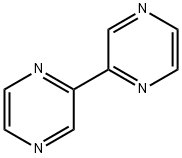2,2'-BIPYRIDINE-6,6'-DICARBOXYLIC ACID
- CAS NO.:4479-74-7
- Empirical Formula: C12H8N2O4
- Molecular Weight: 244.2
- MDL number: MFCD11042476
- EINECS: 806-930-0
- SAFETY DATA SHEET (SDS)
- Update Date: 2024-06-12 10:05:38

What is 2,2'-BIPYRIDINE-6,6'-DICARBOXYLIC ACID?
The Uses of 2,2'-BIPYRIDINE-6,6'-DICARBOXYLIC ACID
2,2′-Bipyridine-6,6′-dicarboxylic acid (BPDC) is an organic heterocyclic compound belonging to the bipyridine family. It consists of two pyridine rings linked by a carbonyl group. BPDC is used in the synthesis of organic compounds, enzyme inhibition studies, development of molecular probes and molecular recognition studies.
Properties of 2,2'-BIPYRIDINE-6,6'-DICARBOXYLIC ACID
| Melting point: | 286℃ |
| Boiling point: | 568.1±50.0 °C(Predicted) |
| Density | 1.469 |
| storage temp. | Inert atmosphere,Store in freezer, under -20°C |
| form | powder to crystal |
| pka | 2.97±0.10(Predicted) |
| color | White to Almost white |
| λmax | 288nm(H2O)(lit.) |
| CAS DataBase Reference | 4479-74-7 |
Safety information for 2,2'-BIPYRIDINE-6,6'-DICARBOXYLIC ACID
| Signal word | Warning |
| Pictogram(s) |
 Exclamation Mark Irritant GHS07 |
| GHS Hazard Statements |
H315:Skin corrosion/irritation H319:Serious eye damage/eye irritation H335:Specific target organ toxicity, single exposure;Respiratory tract irritation |
| Precautionary Statement Codes |
P261:Avoid breathing dust/fume/gas/mist/vapours/spray. P305+P351+P338:IF IN EYES: Rinse cautiously with water for several minutes. Remove contact lenses, if present and easy to do. Continuerinsing. |
Computed Descriptors for 2,2'-BIPYRIDINE-6,6'-DICARBOXYLIC ACID
New Products
4-Fluorophenylacetic acid 4-Methylphenylacetic acid N-Boc-D-alaninol N-BOC-D/L-ALANINOL Tert-butyl bis(2-chloroethyl)carbamate 3-Morpholino-1-(4-nitrophenyl)-5,6-dihydropyridin- 2(1H)-one Furan-2,5-Dicarboxylic Acid Tropic acid S-2-CHLORO PROPIONIC ACID ETHYL ISOCYANOACETATE 2-Bromo-1,3-Bis(Dimethylamino)Trimethinium Hexafluorophosphate (6-METHYL-[1,3]DITHIOLO[4,5-b]QUINOXALIN-2-ONE INDAZOLE-3-CARBOXYLIC ACID 4-IODO BENZOIC ACID (2-Hydroxyphenyl)acetonitrile 4-Bromopyrazole 5,6-Dimethoxyindanone 2-(Cyanocyclohexyl)acetic acid 4-methoxy-3,5-dinitropyridine 2-aminopropyl benzoate hydrochloride 1-(4-(aminomethyl)benzyl)urea hydrochloride diethyl 2-(2-((tertbutoxycarbonyl)amino) ethyl)malonate tert-butyl 4- (ureidomethyl)benzylcarbamate Ethyl-2-chloro((4-methoxyphenyl)hydrazono)acetateRelated products of tetrahydrofuran








You may like
-
 2,2'-Bipyridine-6,6'-dicarboxylic Acid CAS 4479-74-7View Details
2,2'-Bipyridine-6,6'-dicarboxylic Acid CAS 4479-74-7View Details
4479-74-7 -
 2033-24-1 98%View Details
2033-24-1 98%View Details
2033-24-1 -
 1975-50-4 98%View Details
1975-50-4 98%View Details
1975-50-4 -
 2-HYDROXY BENZYL ALCOHOL 98%View Details
2-HYDROXY BENZYL ALCOHOL 98%View Details
90-01-7 -
 2-Chloro-1,3-Bis(Dimethylamino)Trimethinium Hexafluorophosphate 221615-75-4 98%View Details
2-Chloro-1,3-Bis(Dimethylamino)Trimethinium Hexafluorophosphate 221615-75-4 98%View Details
221615-75-4 -
 61397-56-6 CIS BROMO BENZOATE 98%View Details
61397-56-6 CIS BROMO BENZOATE 98%View Details
61397-56-6 -
 14714-50-2 (2-Hydroxyphenyl)acetonitrile 98+View Details
14714-50-2 (2-Hydroxyphenyl)acetonitrile 98+View Details
14714-50-2 -
 118753-70-1 98+View Details
118753-70-1 98+View Details
118753-70-1
Statement: All products displayed on this website are only used for non medical purposes such as industrial applications or scientific research, and cannot be used for clinical diagnosis or treatment of humans or animals. They are not medicinal or edible.